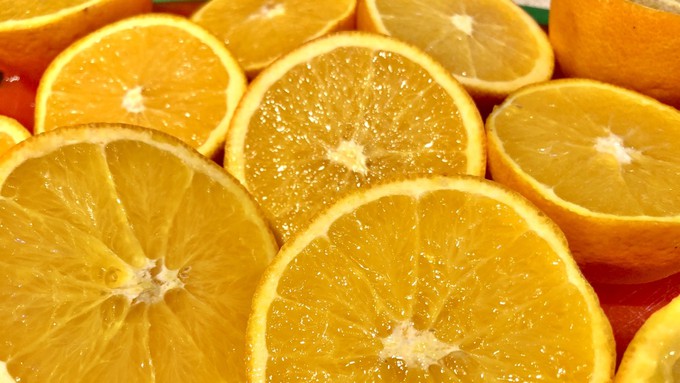
Enjoy winter fruit and vegetables with these home-grown recipes

Fresh-off-the-tree oranges mean winter to those of us lucky enough to live in California. Find several citrus-based recipes in the "Taste Winter! cookbook. Kathy Morrison
Beat the winter blahs with cool-season aahs!
Elsewhere around the country, snow and freezing weather shuts down garden-minded cooks. But here in Sacramento, we make full use of year-round gardening – and our cool-season harvest.
See how in “Taste Winter!,” the latest in our collection of seasonal e-cookbooks.
In this Sacramento Digs Gardening recipe collection, discover almost 70 delicious ways to enjoy our local harvest of winter fruit and vegetables. Packed with nutritious fresh produce, these recipes will help you eat healthier, too.
Start your day with a hearty, fruity breakfast treat such as fluffy lime scones or triple apple coffee cake. In this collection, find 18 breakfast recipes to wake up your taste buds.
Leafy green vegetables such as kale, spinach and bok choy come into season at the same time we’re trying to eat healthier – at the start of the new year – and when we really need that added dose of antioxidants. Enjoy vegetable-forward main dishes, salads and soups that are packed with nutrients and great taste. (There are several vegetarian options, too!)
Asparagus – a seasonal treasure – sprouts with the first warmth of late February or March. It’s been a local favorite for generations in such recipes as baked asparagus a la Sacramento.
What about fruit? Citrus – California’s star winter crop for generations – adds zest and juicy flavor to a wide range of winter recipes from blood orange mimosas and grapefruit-roasted beet-avocado chopped salad to fresh lemon pasta and Meyer lemon crème brûlée. Simple kumquat sauce can go sweet (as a dessert-like topping for yogurt or pound cake) or savory as a tart complement to grilled chicken or pork tenderloin.
Apples and persimmons may be holdovers from late fall, but they add sweetness and flavor to hearty desserts and baked goods.
In late winter, the season’s first strawberries can be showcased in old-fashioned desserts such as strawberry fool or strawberry spoon cake.
So many possibilities! These recipes prove that – even in the dark days of winter – you still can eat local, in season – and fresh. (That’s another reason why we dig gardening – and cooking – in Sacramento!)
Find this new e-cookbook at: https://sacdigsgardening.californialocal.com/article/83747-taste-winter-recipes-from-your-garden/
What’s cooking in this collection?
Featured vegetables include: Asparagus, beans (dried), beets, bok choy, Brussels sprouts, butternut squash, cabbage, cardoon, carrots, cauliflower, chard, fava greens, fennel, garlic, greens, kale, leek, onion, potato, pumpkin, spinach, sweet potato and turnip.
Featured fruit and nuts include: Almond, apple, avocado, grapefruit, kumquat, lemon, lime, mandarin, orange, rose hip, persimmon, pomegranate and strawberry.
Comments
0 comments have been posted.Sacramento Digs Gardening to your inbox.
Food in My Back Yard Series
May 6: Maintain soil moisture with mulch for garden success
April 29: What's (already) wrong with my tomato plants?
April 22: Should you stock up on fertilizer? (Yes!)
April 15: Grow culinary herbs in containers
April 8: When to plant summer vegetables
April 1: Don't be fooled by these garden myths
March 25: Fertilizer tips: How to 'feed' your vegetables for healthy growth
March 18: Time to give vegetable seedlings some more space
March 11: Ways to win the fight against weeds
March 4: Potatoes from the garden
Feb. 25: Plant a fruit tree now -- for later
Feb. 18: How to squeeze more food into less space
Feb. 11: When to plant? Consider staggering your transplants
Feb. 4: Starting in seed starting
Sites We Like
Garden Checklist for week of May 11
Make the most of the lower temperatures early in the week. We’ll be back in the 80s by Thursday.
* Plant, plant, plant! It’s prime planting season in the Sacramento area. Time to set out those tomato transplants along with peppers and eggplants. Pinch off any flowers on new transplants to make them concentrate on establishing roots instead of setting premature fruit.
* Direct-seed melons, cucumbers, summer squash, corn, radishes, pumpkins and annual herbs such as basil.
* Harvest cabbage, lettuce, peas and green onions.
* In the flower garden, direct-seed sunflowers, cosmos, salvia, zinnias, marigolds, celosia and asters. (You also can transplant seedlings for many of the same flowers.)
* Plant dahlia tubers.
* Transplant petunias, marigolds and perennial flowers such as astilbe, columbine, coneflowers, coreopsis, dahlias, rudbeckia and verbena.
* Keep an eye out for slugs, snails, earwigs and aphids that want to dine on tender new growth.
* Feed summer bloomers with a balanced fertilizer.
* For continued bloom, cut off spent flowers on roses as well as other flowering plants.
* Add mulch to the garden to maintain moisture. Mulch also cuts down on weeds. But don’t let it mound around the stems or trunks of trees or shrubs. Leave about a 6-inch-to-1-foot circle to avoid crown rot or other problems.
* Remember to weed! Pull those nasties before they set seed.
* Water early in the day and keep seedlings evenly moist.